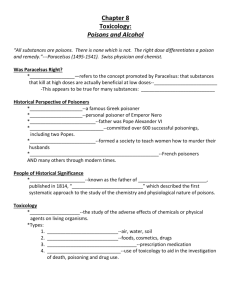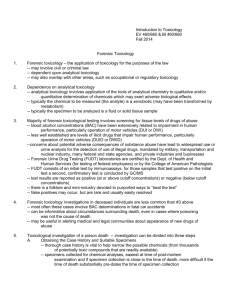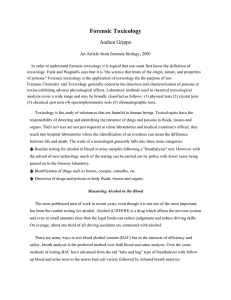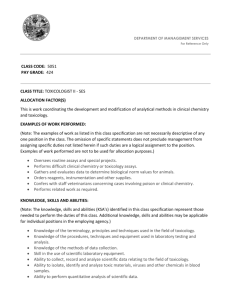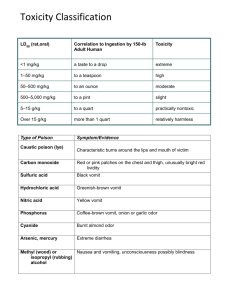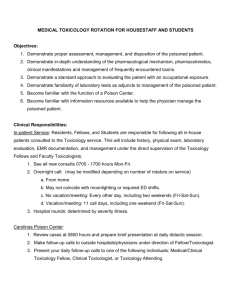9 Toxicology
advertisement
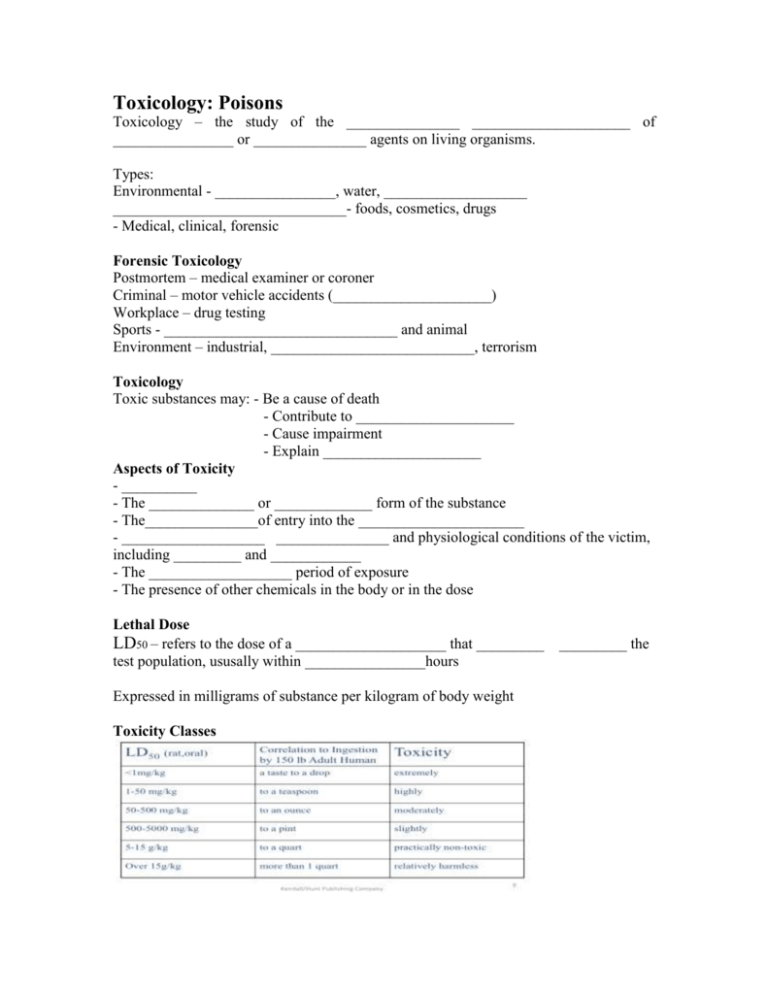
Toxicology: Poisons Toxicology – the study of the _______________ _____________________ of ________________ or _______________ agents on living organisms. Types: Environmental - ________________, water, ___________________ _______________________________- foods, cosmetics, drugs - Medical, clinical, forensic Forensic Toxicology Postmortem – medical examiner or coroner Criminal – motor vehicle accidents (_____________________) Workplace – drug testing Sports - _______________________________ and animal Environment – industrial, ___________________________, terrorism Toxicology Toxic substances may: - Be a cause of death - Contribute to _____________________ - Cause impairment - Explain _____________________ Aspects of Toxicity - __________ - The ______________ or _____________ form of the substance - The_______________of entry into the ______________________ - ___________________ _______________ and physiological conditions of the victim, including _________ and ____________ - The ___________________ period of exposure - The presence of other chemicals in the body or in the dose Lethal Dose LD50 – refers to the dose of a ____________________ that _________ test population, ususally within ________________hours Expressed in milligrams of substance per kilogram of body weight Toxicity Classes _________ the Federal Regulatory Agencies - ___________________ and ___________________ Administration (FDA) - Environmental Protection Agency (EPA) - Consumer ___________________ __________________ Commission - Department of Transportation (DOT) - _______________________ __________________ and Health Administration (OSHA) Symptoms of Various Types of Poisoning Type of Poison Caustic Poison (Lye) Symptom/Evidence Characteristic burns around the lips and mouth of the Victim Carbon Monoxide __________________ or _______________ patches on the chest and thighs, unusually bright red lividity Sulfuric Acid ________ __________ Hydrochloric Acid Greenish-Brown vomit Nitric Acid Yellow Vomit Phosphorous Coffee brown vomit, _______ or _______ odor Cyanide Burnt almond odor Arsenic, Mercury Pronounced diarrhea Methyl (wood) or ________________ and vomiting, unconsciousness, Isopropyl (Rubbing) alcohol possibly blindness Critical Information on Poisons Form ________________ color Characteristic odor Solubilty ________________ Common sources Lethal Dose Mechanism Possible __________ of Administration • • • • • • • • • Symptoms resulting from an acute _______________ Symptoms resulting from chronic exposure Disease states mimicked by poisoning Notes relating to the ___________ Specimens from victim Analytical detection methods Known _________ levels Notes pertinent to analysis of poison List of cases in which _________ was used Time interval of onset of symptoms To Prove a Case Prove a crime was committed ____________________________ _____________________ Access to _____________________ Access to _________ Death was caused by poison Death was __________ Forensic Autopsy Look for: Irritated _____________________ Characteristic _________________ Mees lines – single transverse _____________________ _____________________ on _____________________ Order toxicological screens Postmortem concentrations should be done at the scene for comparison No realistic calculation of dose can be made from a single measurement Human Specimens for Analysis Blood Liver tissue Urine Brain tissue Viterous ________ of _____ __________ tissue Bile ________/_________ Gastric Contents Toxicology: Alcohol Alcohol – Ethyl Alcohol (C2H5OH) Most abused drug in America About ____% of all traffic deaths are _________-related Toxic – affecting the ________ _________ _________, especially the brain Colorless liquid, generally diluted in water Acts as a depressant Alcohol appears in blood within minutes of ___________; 30 – 90 minutes for full absorption _____________ - about 90% in the liver About 5% is excreted unchanged in breath, perspiration and urine Rate of Absorption Depends on: - amount of alcohol consumed - the _____________ content of the ____________ - time taken to consume it - quantity and type of food present in the stomach - physiology of the _______________ BAC : Blood Alcohol Content Expressed as percent _________________ per ________________ of blood Legal limits in all states is ________________% Parameters influencing BAC: - Body __________________ - Alcoholic _____________________ - ___________________of beverages consumed - Time between consumption Burn off rate of ___________% per _________ but can vary: Male BAC male = 0.071 x (ox) x (% alcohol) Body weight Female BAC female = 0.085 x (oz) (% alcohol) Body weight HENRY’S LAW When a volatile chemical is dissolved in a liquid and is brought to _____________________ with air, there is a fixed ratio between the concentration of the volatile compound in the___________and its concentration in the _____________; this ratio is _____________________ for a given temperature. THEREFORE, the _____________________ of _____________________in _____________________ is _____________________ to that in the _____________________. This_________________ of ______________in the _____________________ to _______________ in the alveolar _________________ is approximately 2100 to 1. In other words 1 ml of blood will contain nearly the same amount of alcohol as 2100 ml of breath. FIELD TESTS Preliminary tests—used to determine the _________________ of suspect’s _________________ _________________ and whether or not another test is _________________. Psychophysical tests—3 Basic Tests o _______________ ______________ _____________ (HGN): _____________ a pen or small flashlight, ______________ left to right with one’s eyes. In general, wavering at _________________indicates __________ __________. o Nine Step walk and turn (WAT): _________________and _________________ _________ or _________ simple instructions at ___________ ____________. o One-leg stand (OLS): maintain _________________, _________________ and _________________ __________ or ___________ simple instructions at __________ __________. Breathalyzer More practical in the field ________________and ________________ alcohol content of ________________ breath Breath sample mixes with 3 ml of 0.025 % K2Cr2O7 in ________________ ____________ and ________________ 2K2Cr2O7 + 3C 2H5OH + 8H 2SO4 2Cr2(SO4)3 + 2K2SO4 + 3CH3COOH + 11 H2O ________________ ________________ is yellow, as concentration ________________ its light absorption diminishes so the breathalyzer indirectly measures alcohol concentration by measuring light absorption of potassium dichromate ________________ and________________the ________________ with ________________ Generalizations During absorption, the concentration of alcohol in _______________ blood will be _______________ than in _______________ blood. _______________ tests reflect alcohol _______________ in the _______________ _______________. The _______________ also can react with _______________ (as found with diabetics), acetaldehyde, methanol, isopropyl alcohol, and paraldehyde, but these are _______________ and their _______________means the person is in serious _______________ _______________. Breathalyzers now use an infrared light absorption device with a digital read-out. Prints out a card for a permanent record.



